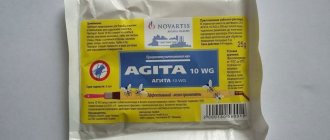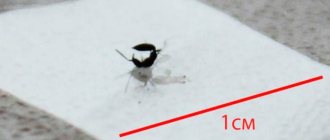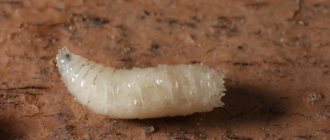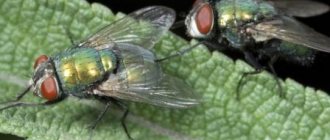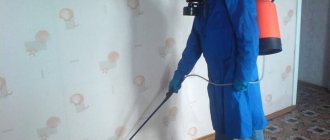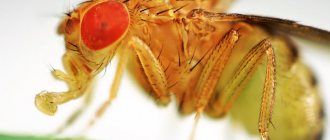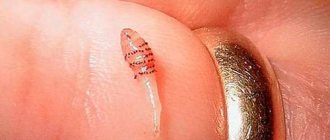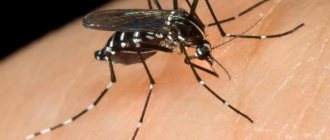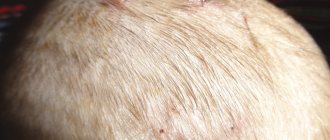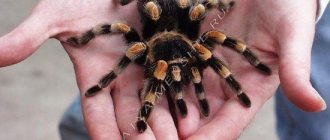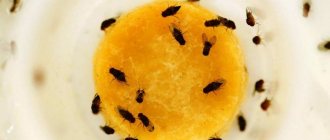20.01.2017
It is very unpleasant when a fly flies around in an apartment, and not just one, but a whole swarm. These insects are not only annoying with their buzzing, but can also infect a person with many dangerous diseases, such as diphtheria, dysentery and even cholera. To effectively remove these pests, you need to find out why flies appear in the apartment, and only after that you can begin active actions to destroy them.
- Where do they come from?
- Reasons for appearance
- What to do if you appear
- Prevention of occurrence
Where do flies come from in an apartment?
The question of where flies come from worries many clean housewives, especially since insects often appear even indoors. There are only two options:
- the fly flew in on its own;
- the insect, eggs or larvae were brought by someone who visited the apartment.
In the first case, insects enter the apartment through open windows, doors, ventilation systems, sewers, cracks in window frames, door frames or walls.
Flies can appear after fruits or vegetables, flowers, or soil contaminated with eggs are brought into the house. Eggs or larvae can stick to outdoor shoes or get on your pet's clothing or fur during a walk.
in spring
Many summer residents, making their first test forays outside the city in the spring, are perplexed as to where the flies came from in a house locked for the winter. Most often, the cause of insects is eggs or larvae that were laid in the fall and overwintered somewhere in the bowels of the house. With the arrival of spring, the temperature began to rise, the development of insects resumed, and now the owners of the dacha are greeted by several young flies with the discordant buzzing.
Another explanation for the fact that flies appeared in a house or apartment in the spring is that they spent the winter in a secluded place, and now they have woken up. This option is also possible - the early spring was very warm and a new generation of flies was born, then the cold returned and the insects entered warm human habitation in search of warmth.
Read also: Why does a dog drink its own urine?
In summer
Where flies come from in the house in the summer is clear to everyone. It is during the warm season that insects are most active. There is simply an infestation of flies in houses and apartments. Most often they fly into rooms through windows that are open for ventilation. Residents of houses whose windows overlook garbage dumps and garbage cans suffer the most.
But even with the windows closed, getting into the room is not a problem for flies. Any small opening for her is a hospitably open gate. And if we are talking about a wooden house, in which there are always cracks and cracks, then insects penetrate there with ease. There are always more flies in the country. After all, nearby there is a plot with flowers, fruit trees, beds, compost heaps, often cesspools or street toilets.
In addition, buildings for keeping animals are often located next to private houses. In cowsheds, chicken coops, and pigsties there are always a lot of flies that periodically fly into the house.
In the house
You can even bring flies with a bouquet of wild or garden flowers, and eggs or larvae can be found on vegetables and fruits collected from the garden or purchased at the market.
Sciarida (flower midge, fungus or soil gnat)
The flies are 3-4 mm in size and black. They are malicious pests of indoor flowers. Mature small flies do not pose a danger, but their larvae cause irreparable damage to the roots of the plant.
Sciarida
Their habitat is soil, damp basements of houses. They enter the room through ventilation, with soil for plants. They also feed on fruits, rotting vegetables, and food waste. They do not cause harm to humans, but if you do not start fighting, indoor flowers may suffer.
Prevention of the appearance of sciarids, methods of control:
- Dry the soil to a depth of 2 cm to destroy pest eggs.
- Place expanded clay and gravel on top of the soil. This will prevent the fly from reproducing in the ground.
- Remove dry flower buds and leaves in a timely manner.
- Do not water flowers with milk, broth, etc. They lead to active reproduction of flies due to rotting.
- Water the plant a couple of times a month with a small dose of potassium permanganate solution.
For disinfestation of premises, insecticidal sprays, aerosols, and concentrates are used.
How to avoid flies in your apartment?
Protecting your home from flies is much easier than fighting insects already flying in it. Moreover, you don’t need to do anything special for this. The main thing is to maintain cleanliness and follow a few simple rules:
- in the warm season, install mosquito nets on the windows;
- Take out the trash every day, wash the trash can, and close it with a lid;
- immediately after eating, clear the table, throw away leftovers, clean up, etc.;
- do not leave dirty dishes in the sink;
- regularly do wet cleaning in the kitchen, wash the stove, sink;
- avoid dampness, make sure there are no leaks, water houseplants moderately, wring out sponges and rags thoroughly;
- If possible, store vegetables and fruits in the refrigerator, periodically sort through them, throw away those that begin to spoil;
- carefully inspect fruits, vegetables and herbs before purchasing so that there are no eggs laid on them;
- Seal the ventilation holes in the house with fine mesh.
These recommendations will help you avoid many problems that may arise if flies appear and breed in your house.
"Onion Mountain"
People who like to grow vegetables in their garden may encounter so-called onion flies in their apartment.
This harmful insect appears in the beds and can destroy the entire crop. Flies brought home along with root vegetables or appearing on a plant grown on a windowsill will cause serious discomfort to apartment owners.
To get rid of onion flies, you need to follow these recommendations:
- Before planting onions on the windowsill, treat the soil with pest control solutions;
- If tomato seedlings grow next to the onions, the fly will not appear at all;
- Hang bunches of mint or pine needles in the room. Appropriate aromatic oils can be used;
- The smell of camphor will allow you to send uninvited guests away very quickly.
To prevent onion flies from appearing in your apartment, you should carefully shake off the soil from your country onions before taking them home.
How to quickly and effectively get rid of flies?
Flies in the house? Not the most pleasant company. In spring, the number of insects in the apartment increases, and the urgent question arises of how to get rid of flies and make sure that they no longer appear.
Before you start fighting these flying insects, you need to determine where they come from, otherwise all your efforts will be in vain. So, let's figure it out.
In the warm season, they can fly from windows, balconies, doors and even from ventilation openings. It happens that it has not yet warmed up outside, but they are already flying around in the house.
These are insects that in the fall hid in crevices, secluded places for hibernation, and in the spring they come to life again and begin their “mission” of annoying people. If there is even the slightest hint of unsanitary conditions in the apartment, then flies will love this place, because they are attracted by the smells of rotting food and dirt.
Annoying buzzing, flying from one place to another, “travelling” through food and through your body cause irritation and psychological discomfort. It would be easier if the harm from insects was limited only to unpleasant emotions. They can be very dangerous for humans.
General information about insects
Harmful insects often fly into your home when the windows are open when it gets warm. Often these creatures are the first to wake up after hibernation, crawling along window sills and the kitchen table. Buzzing creatures cause irritation and hostility; an abundance of insects often indicates unsanitary conditions.
A few facts about the life of flies:
- body length – up to one and a half centimeters, some species grow up to 7.5 cm;
- pests feed on liquefied food through a thin proboscis. Taste buds are located on the paws, giving an idea of the product. Flies prefer sweets: compote, jam, jam, honey, fruit juices. Pests often feed on rot accumulated in the trash can, food remnants that were not removed from the table in time;
- Unpleasant creatures have almost panoramic vision, they perfectly see objects not only in front of them. That is why it is so difficult to destroy a fly, which easily recognizes the “offender” with a slipper and quickly flies away;
- Sensitive hairs on the body and mustache sense the slightest vibrations in the air. This fact explains the disappearance of the pest shortly before the moment the fly swatter touches the place where the harmful insect was located a couple of seconds ago;
- The worse the conditions, the lower the temperature, the faster the buzzing creatures die out. In an unfavorable environment, insects rarely survive beyond 20 days;
- the optimal temperature for the life and reproduction of winged pests is from +23 C to + 35 C;. If humidity reaches 80% and temperatures remain in the specified range, flies can live up to 60–70 days;
- average life expectancy is 25 days. The reason is numerous enemies, for example, a person who does not want to tolerate annoying “neighbors” in the house. In the home and in the fresh air there are many spiders and birds that happily eat buzzing insects;
- active reproduction saves flies from extinction: in such a short period of life, the female lays 2000 eggs or more. 2 weeks pass and the transformation into an adult is completed. At such a rate of reproduction, the number of flies on the planet is not decreasing; the annoying pests survive in any weather conditions;
- high reproduction rate, good adaptability to different temperature conditions ensures excellent survival of eggs and adults. Timely pest control prevents the appearance of colonies of harmful insects in the apartment.
When the air temperature drops, harmful insects become lethargic, barely crawl, and then hibernate. It is no coincidence that slow people are called “sleepy flies.” If there is a thaw in winter or the apartment warms up to +23 degrees, the unpleasant “neighbors” come to life. This is why flies are found in residential areas in December-January.
Popular methods of controlling flies in an apartment and house
Fly traps are very popular and effective in controlling insects. They can be made from available materials. The most common types of traps among the population are:
- You need to place bait in a glass jar, which can be honey, syrup, or sugar-sweetened water. A paper cone is inserted into the jar so that the wide part is located on top, and the narrow part is located from the bottom of the jar, but not close to it. Insects attracted by the bait will fly into the jar through the hole in the cone, but will not be able to get out.
- The most basic trap is an open bottle of beer with some drink left in it. The flies will flock to the smell, penetrate the bottle and will not be able to fly out.
- The following trap is also effective: pour a little vinegar with a few drops of dishwashing liquid into a glass jar. Wrap the top of the jar with cling film and make a hole in it to fit an adult fly. A fly that has flown into a jar will not be able to escape and will drown in the prepared mixture.
Attractive factors
And yet, why are there no flies in some homes, while in others they swarm in a black ball? What is the reason? The answer lies in the insect's ability to sense the attractive smell of food waste. The conclusion suggests itself. Neglect to maintain cleanliness and order in the house is an invitation card for a winged company. The first room on the list of attractive places is the kitchen, from where insects can easily spread throughout the room. With a careless housewife, flies will always find many places where there is something to profit from:
- a trash can full of rotting waste;
- dirty dishes in the sink;
- leftover food and bread crumbs on the table;
- a bowl, a pet's toilet, and even microscopic traces from its walks through the rooms.
These places are a favorable breeding ground for insects. This is why keeping your home clean will reduce the risk of nuisance tenants breaking in and developing. With the onset of autumn, you can't relax. The warmth of human habitation attracts unpleasant guests seeking to find a comfortable place to sleep. There are many such corners in the house. The task of winged aliens is to hide in them. Another attractive factor is the high humidity zone.
Unwashed dishes attract flies
Reproduction in apartments
The fly lays eggs in pots with indoor plants, in rotten fruits and vegetables, and also in places that are not clean. Although insects do not reproduce so actively in apartments, especially in winter, after a couple of weeks adult individuals emerge from the eggs and scatter throughout the apartment.
The main condition for reproduction is suitable temperature conditions, as well as unsanitary conditions. This is facilitated by garbage that is stored for a long time in the trash can, as well as the storage of vegetables and fruits in apartment conditions, which leads to their premature spoilage. It is under such conditions that flies actively lay eggs.
The female is capable of laying up to 150 eggs in one day. At the same time, she puts them aside every couple of days. It is not difficult to imagine that in just one week a whole colony of insects can appear in the house. If a fly lays eggs today, then on the second day larvae (maggots) appear from the eggs.
The maggots that are born are not large in size (only 1 mm), so they are very difficult to notice at this stage. After about 10 days, under comfortable conditions, the larva turns into a pupa. After another 3 days, an adult fly flies out of the pupa, ready to lay eggs to continue its lineage. If you carry out basic calculations, then after laying eggs, after 2 weeks, more than a hundred flies may appear in the apartment.
It is important to know! The blowfly is also capable of laying eggs indoors, but it will require certain conditions to develop. Its larvae consume protein foods. A new generation of blowflies will appear when a piece of spoiled fish or meat remains somewhere. If there are no such conditions for development, then the larvae will die at one of the stages of their development. Therefore, apartment conditions are conditions for the development of house flies.
Drosophila (fruit, vinegar or wine fly)
The body length of a small insect is up to 3 mm, the wings are longer than the body. Red color of the body. Red eyes are visible on the head. Drosophila is extremely prolific. In less than 10 days, the egg turns into a sexually mature individual, which lays eggs on the second day.
Drosophila flies
Small flies eat sour juices, which begin to rot vegetables, fruits, and berries. The main habitat of fruit flies is vegetable and fruit warehouses, fruit trees. Products contaminated with eggs and Drosophila larvae end up in mass sales and then on the human dinner table. Reproduction is also facilitated by acidified soil in flowers overflowing with water. Often in an apartment or house, the Drosophila fly appears after transplanting plants; eggs and larvae of pests are initially found in the soil.
Effective remedies for Drosophila fruit fly, effective methods:
- Pour any juice, compote, syrup or kvass into any deep container with a narrow neck; instead, you can put a piece of any fruit at the bottom. Make a cone out of yellow paper and insert it into the neck of the container. It’s good to fix everything so that there are no gaps. Place a trap for small fruit flies in the kitchen.
- To get rid of small flies in the soil, it is enough to reduce the amount of watering, dry the soil, stick 5 matches along the perimeter with the sulfur down.
- Collect fruit cores in a bag, wait until a swarm of small fruit flies flocks to the bag, tie tightly, and immediately throw in the trash.
- Mix apple cider vinegar and dish detergent into a deep container. Place bait for small fruit flies in the kitchen.
It is necessary to carry out general cleaning in the kitchen, in the room where midges fly, to eliminate rotting, decomposing organic matter, and the remains of soil in vegetable storage boxes.
Fly repellents
Traps
Self-made traps should contain bait - pieces of fruit, syrups, jam. In parallel with the destruction of flies found in the room, install nets on the windows to prevent new insects attracted by odors from the trap from flying in. Instructions for making a trap are given below.
Ribbons
There are many options for specialty insect tape. It is hung on the ceiling or chandelier, the flies land on the trap, stick and die. You can make the tape yourself: cut the paper into strips, lubricate it with rosin or resin in which castor or linseed oil, glycerin and sugar are dissolved. The mixture must be prepared in a water bath.
Fumigators
They are best used in enclosed spaces where people and pets should leave for a while. Close the windows and doors, plug the fumigator into an outlet and wait the required time, which is indicated in the instructions for the product. Then the room needs to be ventilated, and it is advisable to have nets on the windows to prevent insects from flying into the treated apartment again.
Aerosol sprays
It is extremely important to use insecticidal products away from food and personal hygiene items. Make sure that pets do not enter the treated area for a couple of hours - chemical sprays can be dangerous for them. After use, ventilate the room and wipe the surfaces on which the sprayed substance has settled with a damp cloth.
Essential oils
Like many insects, flies are sensitive to odors. Try lighting citronella candles or an aroma lamp with essential oils of lavender, basil, eucalyptus or mint. You can also add them to water and spray door frames and window sills with a spray bottle.
Plants
Some herbs have a sharp, specific odor that repels flies. You can arrange branches of wormwood, bird cherry, elderberry or nettle in vases or place them in a room with flies. Both fresh and dried plants are suitable - for some time they also spread a bright aroma around.
Darkness
Flies are attracted to light. Therefore, if you darken the room, leaving only the window open, there is a chance that the insects will fly out. But this method is only relevant if there is nothing in the room that could interest them - drinks, food, dirt and garbage. Otherwise, the flies will continue to feed and reproduce without trying to leave the apartment.
Fly swatters and vacuum cleaner
An old, proven way to destroy some insects is physical impact; a rolled-up newspaper or commercially available fly swatters are suitable here. Flies can be collected with a vacuum cleaner, but the contents of the collection bag must then be thrown away immediately. But such methods are good if there are only one or two insects in the apartment or the owners want to relieve nervous tension.
Photo: Shutterstock
Professional disinfection
If there are too many insects, and the available methods have been tried and do not help, it makes sense to turn to exterminators. Specialists will process the premises.
Methods of disposal
Since dipterans have been living near us for a very long time, over many centuries of proximity, many ways have been invented to remove them. These include both traditional folk recipes and modern developments.
Physical destruction
The simplest thing is to kill all the insects using a fly swatter or folded newspaper. There are several obvious disadvantages:
- effective only against a small number of flying parasites;
- you will have to work hard to catch up with the fly, wait until it lands on the wall or furniture, and only then swat it;
- only adult individuals are destroyed, and a large number of new ones will soon appear from the laid eggs;
- there is a risk of ruining the interior: a smeared bloody trail is a dubious decoration.
Today there are more advanced tools for fighting that do not require your participation and are absolutely harmless.
Important! Here you can find information about devices that do not use toxic chemicals. They are safe for allergy sufferers and small children.
You can realize the hunter's instinct without spoiling the finish using an electric fly swatter. You need to track a fly in the same way as with a regular one, but you don’t have to wait until it lands: when the insect touches the surface, it gets shocked and falls dead.
Ultraviolet lamps are installed on a table or hung on a wall. They attract pests with ultraviolet radiation, and when they get closer, they destroy them with a discharge of current.
Here's another interesting option: plant a houseplant like a Venus flytrap. This is a predatory flower that attracts insects and eats them. Not only does it bring tangible benefits, but you can also brag to your friends.
One of the methods my grandmother used was expulsion. Suitable for situations where there is a lot of clattering noises, but there is no possibility of poisoning. The windows in the room are tightly curtained to create pitch darkness, while the door or one window is left open and light enters through it. You need to take a medium-sized piece of fabric (a folded sheet or towel) in your hands, and actively fan the room to drive flies away from their homes. They see the light and actively fly towards it, getting rid of their annoying presence.
Traps
Their essence is simple: to attract house flies to your contents and prevent them from getting out of the trap.
The most famous trap is a sticky tape in the form of a spiral; such traps are sold everywhere. The special impregnation attracts uninvited guests, and they flock to its aroma.
The tape needs to be secured where the greatest concentration of buzzing creatures is observed, and replaced with a new one as necessary.
Cheap and effective, but the interior value of such “decoration” is highly questionable.
You can make similar Velcro with your own hands. For production you will need:
- 100 grams of castor or sunflower oil;
- 200 grams of rosin;
- 1 tbsp. l. honey or jam.
Wrapping or landscape paper is suitable as a base. It must be cut into strips 4-5 cm wide and approximately 50 cm long. Attach a loop to one of the sides so that the bait can be hung conveniently, and to the bottom part - a clothespin or several paper clips so that the paper does not curl.
Melt the rosin in a water bath. When the substance begins to boil, pour oil into it and stir until smooth, without removing from heat. Then add honey or jam.
While still hot, apply the mixture onto the strips, the layer should not be thicker than 2-3 mm. All that remains is to place the blanks in places where flies are most concentrated.
There is an option to make a trap that will also help get rid of midges. To do this, cut the bottle in half and insert it with the neck inside. Pour some beer or water with a couple of spoons of sugar or honey into the bottom. Diptera will flock to the treat and climb inside, but they won’t be able to get out.
Now about ultra-modern integrated solutions. At the dacha and in a private house where there is a livestock farmstead, you can install a street trap in the yard. The range of action of such a device is about 4,000 m, and it is quite capable of reducing the number of pests flying in your area.
The installation produces carbon dioxide and heat, thereby attracting insects. When a fly flies to the source, it is sucked inside, where it dies within 24 hours.
It is allowed to place a device in the form of a lamp with sticky paper behind the grille. The clattering sound flies up to the light and sticks.
Repellers
Efficiency is based on the use of everything that flying creatures are afraid of. These means make it so that they independently leave the home, considering it unattractive. For this purpose, natural and artificial substances that smell unpleasant are used. Some plants and herbs can provide good service.
- Tomato tops that need to be laid out on the windowsill. It’s even better to plant a couple of tomatoes of a variety intended for the balcony.
- Geranium also fights moths, so a pot with this flower will definitely not be superfluous.
- Basil planted under windows or in flowerpots.
- Marigolds in a flowerbed also protect against uninvited guests.
- Hang bunches of bay leaves in your room.
- It would also be a good idea to plant bird cherry trees on the plot, and place its crushed leaves in the corners that the creatures love.
- Fresh or dried mint will also come in handy in a house filled with buzzing creatures.
- Bunches of dried tansy and wormwood will not be tolerated by other parasites, such as moths and ticks.
As an alternative to dried and fresh plants, it is permissible to use essential oils of lemongrass, peppermint, eucalyptus, cloves, and lavender. Mix water and a dozen drops of oil and spray the solution. The aroma will be a pleasant bonus. You can also light an aroma lamp with one of the above oils.
Another option: place clove buds everywhere. An even more effective homemade repeller can be obtained by sticking several buds into a lemon. Or use the method from the video:
Hazel lotion removes illegal neighbors from your apartments and protects them from them in the open air. Prepare a hazel decoction in advance; you will need about 100–150 g. Add table or apple cider vinegar to it in the same volume and 40–50 drops of eucalyptus essential oil. Pour the lotion into saucers and place. If you apply this mixture to exposed areas of your body, flies are guaranteed to fly around you.
Some people recommend cleaning the floor by adding kerosene to the water. But in such a home it will be uncomfortable not only for dipterans, but also for people, so try other methods first.
Sprinkling vodka in the room helps, the pungent alcoholic aroma of which is very disliked by parasites. Soon after processing, they leave the home in search of a new shelter.
Ultrasonic repellers are also used successfully. They emit sound on a wavelength inaudible to humans, but insects really don’t like this repertoire.
However, it is worth considering that the device has a delayed effect, i.e. the effect appears only 2 – 4 weeks after the start of use. The advantage is that the device usually works against mosquitoes, midges or cockroaches.
Toxic substances
When choosing what to poison pests with, there are two ways: folk recipes or purchased products. Of course, specialized insecticides are more effective and they work for sure, while homemade poisons may not help.
In very difficult cases, for example, in a wooden structure where there are many cracks with egg laying, all methods give only a temporary effect. It is advisable not to be brave, but to call the disinfection service. For a fee, they are guaranteed to get rid of your problem.
Folk recipes
There are situations when it is impossible to use chemicals for health reasons or the necessary product is simply not at hand. Then the use of poisons prepared at home is completely justified.
- You should combine 1 tbsp. l. formalin, 5 tbsp. l. sweetened water and 3 tbsp. l. milk. Pour this mixture into saucers and place at several points.
- Another “treat” consists of jam and ground black pepper. Also place baits and watch how in a couple of days the dipterans begin to die.
- Mix water with saccharin and 1 tsp. honey Soak a napkin in the mixture and place it in a visible place.
- Make a decoction of toadflax (sold at the pharmacy) and milk. Pour this delicacy into small plates and place it in your home.
Specialty chemistry
When you want to get results quickly and with less effort, it makes sense to use special means.
Sprays
They are very popular in our country, probably everyone has used them at least once.
When choosing a spray, pay attention to the active ingredient. The repellent should not contain fluorine and chlorine, as they are harmful to humans. Permethrin, cyfluthrin, cypermethrin and the like, the names of which end in “-trin,” are considered safe.
These products include: “Dichlorvos”, Raid, Dr. Klaus, “Raptor”, Combat.
But in any case, it is necessary to take precautions: wear a mask to prevent the aerosol from entering the respiratory tract and mucous membranes, expel everyone, remove edibles and wash after surface treatment.
In addition, it is very important to follow the instructions and recommendations regarding how much aerosol from a can you need to spray onto the volume of the room.
Fumigator
A small device into which a plate or bottle of liquid is inserted. Works from a socket. Thanks to the heating, the poisonous components evaporate and spread throughout the room, having a paralytic effect on the nervous system of the buzzing creatures. At the same time, the poison does not smell at all.
For people, the concentration of vapors is low, but still you should not install the fumigator closer than 1 m from the place where a person is constantly located. And do not forget to ventilate the room after the parasites are destroyed.
Fumigators are produced under the trademarks Picnic, Raptor, Argus, Raid. For families with children, it is better to use specialized options produced by Baby Data and Komaroff.
Chalk
They need to draw lines in areas where pests are most concentrated. The active component contained paralyzes the nervous system, which leads to their death. This happens after about 3-4 days, but strong individuals can last a week. So don't expect immediate work.
The use of this form of insecticide may be unsafe in families with small children or pets.
You can crush the pencil into powder and mix it with water. This composition is used to treat vertical and horizontal surfaces.
The most famous chalk in this group is “Mashenka”, but there are others, for example “Clean House”, “Brownie Proshka”, Crush, “Absolute”.
Powders, granules, suspensions
Typically, such products are produced in the form of powder or granules, which are diluted in water to the required concentration, or are sold ready-made. The surfaces should be treated with the resulting solution and wait for the result.
As an example, we can cite the chemicals “Agita 10 wg”, “Minap 22”, “Executioner”, “Master”.
However, their safety is still in doubt, so it is better to treat with such means in non-residential premises, in the attic, in an outdoor toilet and garage.
Owners of their own farmsteads and summer cottages are recommended to disinfect the surrounding area. This way the number of flies per season will decrease significantly. The drugs usually have a complex effect, that is, they are also harmful to mosquitoes, cockroaches, ants, ticks and other creatures. Use compounds like “Karakurt”, Rubit, “Mukhoyar”.
Bee owners should not do this type of spraying: the poison also destroys honey plants.
Poisons
A fairly effective poison can easily be made at home from improvised means To do this you will need simple ingredients. Let's look at a few recipes :
- A mixture is prepared (1 g of saccharin per 10 g of honey). Paper is impregnated with this composition, which is then dried and laid out on the windowsill and in places where flies accumulate. After laying out, the paper is soaked in a small amount of water.
- Pieces of bread are dipped into small containers with a specially prepared composition: milk (3 tbsp), formaldehyde (0.5 tsp) and soda (5 tsp) and placed near the windows.
- Black pepper is famous for its destructive properties for flies. The following recipe is based on this: black pepper is added to milk, and paper is soaked in this composition. These traps are placed throughout the house. Instead of milk, you can use sweet water.
Fighting an annoying pest
If one or two flies fly into the house, there is no need to think about it for long: you can simply swat the bug as quickly as possible or drive it out. It’s another matter when you need to breed a large number of individuals. First, it’s worth figuring out where exactly they come from: there’s probably a place at home that’s ideal for the pest to breed.
It can be:
- ventilation holes;
- damp, dark areas under the kitchen or bathroom;
- leftover food on forgotten cabinet shelves;
- cracks under baseboards;
- holes leading into the attic or basement.
The darkest, least visited, damp places with food residues are simply a paradise for insects to breed. It is there that they can settle tightly, breeding more and more new generations of flying pests. Such places must be thoroughly treated with insecticidal preparations and cleaned. All cracks should be sealed, and it is better to supplement the ventilation grilles with fine mesh .
There are many ways to deal with annoying flies
It is important not only to destroy the pest, but also to eliminate all possible places where it can lay its larvae over and over again.
As for the fight against adult individuals, there are a huge number of products on the modern market that will help get rid of them.
The most common device is adhesive tape: it is safe for humans and is hung near the ceiling.
The only, and quite significant for many, disadvantage is the unesthetic appearance. A ribbon hanging like a garland, hung with the corpses of insects, is unlikely to please a clean housewife.
The most popular way to combat parasites is sticky tape.
In addition to this method of fighting flies, there are many others, for example:
- suspensions for spraying;
- aerosols;
- fumigators;
- traps.
All of them have both pros and cons, the main one being the content of hazardous chemicals.
Not every apartment owner wants to spray their home with chemicals, especially if there are small children or pets. Therefore, there are also a large number of folk remedies to combat annoying bugs.
Modern methods
Of course, life does not stand still. Methods of combating dangerous insects are constantly being improved and modernized. Below are more effective alternatives to home remedies.
Trap lamps
A more effective and functional analogue of the usual adhesive tape. They are mounted on the wall, have a stylish design and easily fit into the interior. The principle of operation is simple: the fly flies towards the light, but sticks to a trap placed in front of an ultraviolet emitter. In order for the insects to continue to die, it is necessary to periodically change the paper.
Insecticidal lamps
The principle of operation is the same here. The only difference is that dipterans do not stick to paper, but practically end up in the “electric chair”. It's all about the electrical grid through which current is passed. The fly flies towards the light, but eventually dies from the discharge.
Important! A person can take hold of this lattice. For him, the discharge discharge is safe.
Electric fly swatters
This device is ideal for those who like to be on the move. In appearance it resembles a badminton racket, but the plastic base is replaced with a metal one. The fly is shocked by the electric charge.
Electric fumigators
The principle of the device is extremely simple: after connecting to the network, the device begins to evaporate the composition of the tablet, which is toxic to insects. It is effective, but has a significant disadvantage - it is not suitable for large rooms. The optimal area of premises is up to 12 square meters.
